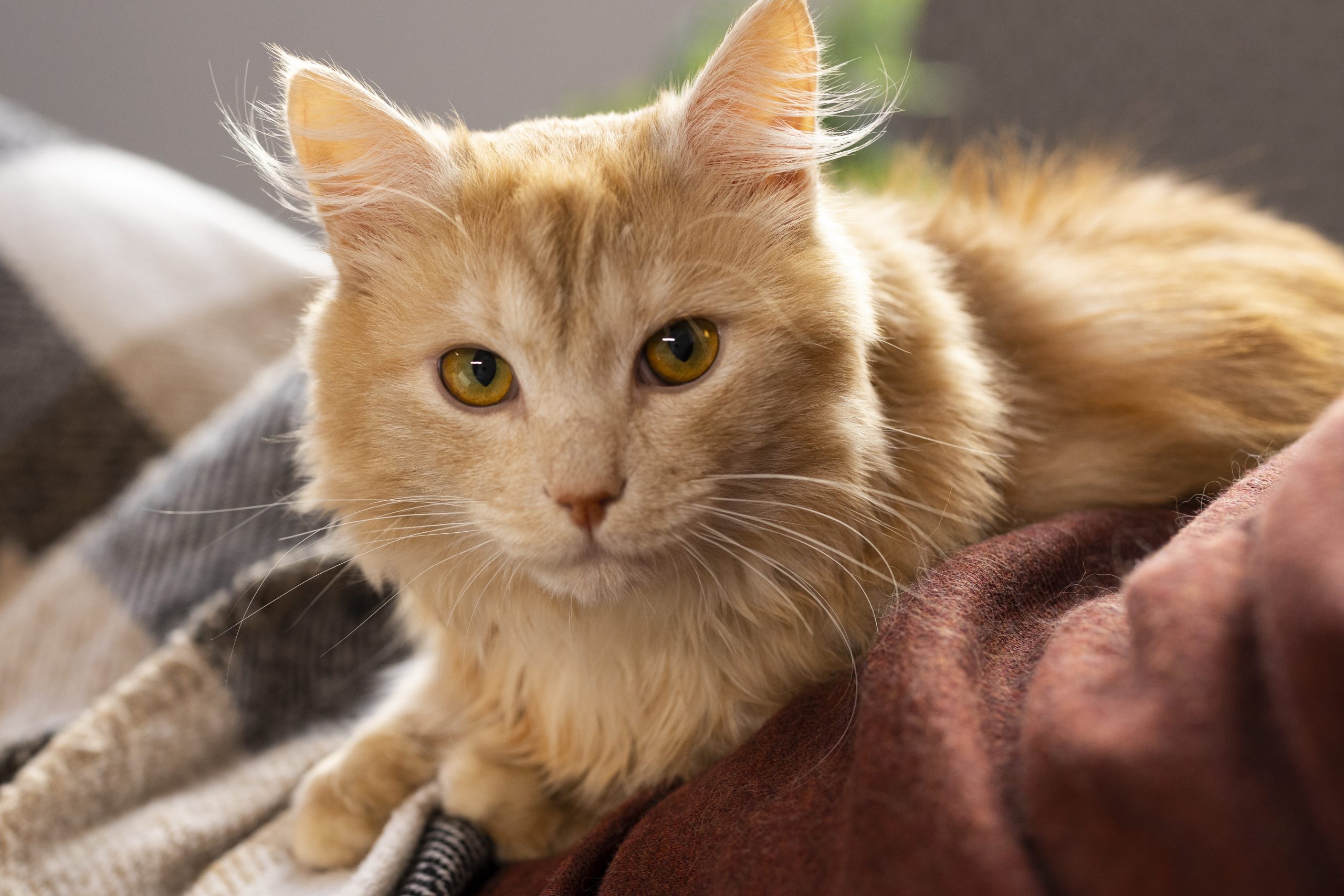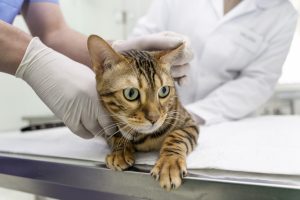Cat Dermatitis: Symptoms, Treatment Options & Cost

Updated July 1, 2025
What Is Feline Dermatitis?
Feline dermatitis, or miliary dermatitis, is a general term used to describe various inflammatory skin conditions that can affect cats. It is characterized by the presence of small, crusty lesions or scabs on the cat’s skin, often accompanied by intense itching and discomfort. Miliary dermatitis can be caused by a variety of underlying factors, ranging from allergies and infections to hormonal imbalances and stress.
Is Miliary Dermatitis in Cats Contagious?
The good news is that miliary dermatitis in cats is not contagious to humans or other pets in the household. It is not a transmissible disease but rather a skin condition that develops as a result of various underlying health issues or environmental factors. However, addressing the underlying cause is important to prevent the condition from worsening or recurring.
Common Symptoms of Feline Dermatitis
Cats with feline dermatitis may exhibit a range of symptoms, including:
- Itching and Scratching: One of the most common and noticeable symptoms of feline dermatitis is intense itching and excessive scratching. Cats may lick, bite, or scratch at their skin, often causing further irritation and damage.
- Skin Redness and Inflammation: The affected areas of the cat’s skin may appear red, swollen, or inflamed, indicating an underlying inflammatory response.
- Hair Loss and Bald Patches: Cats with dermatitis may experience localized or widespread hair loss, which can lead to the formation of bald patches on their skin.
- Presence of Rashes or Bumps: Small, crusty lesions or scabs may develop on the cat’s skin, often in clusters or across multiple areas of the body.
Types and Causes of Feline Dermatitis
Feline dermatitis can be classified into several different types, each with its own underlying causes:
Allergic Dermatitis
- Flea Allergy Dermatitis: Caused by an allergic reaction to flea saliva, often resulting in intense itching and skin irritation.
- Food Allergy Dermatitis: Triggered by sensitivity to certain ingredients in the cat’s diet, such as proteins or carbohydrates.
- Environmental Allergy Dermatitis: Caused by an allergic reaction to various environmental factors, such as pollen, dust, or mold.
Contact Dermatitis
- Irritant Contact Dermatitis: Caused by direct contact with irritating substances, such as household cleaners, chemicals, or certain plants.
- Allergic Contact Dermatitis: Triggered by an allergic reaction to specific substances that come into contact with the cat’s skin.
Infectious Dermatitis
- Bacterial Dermatitis: Caused by bacterial infections, often secondary to underlying skin conditions or injuries.
- Fungal Dermatitis: Caused by fungal infections, such as ringworm, which can lead to hair loss and skin lesions.
Neurogenic Dermatitis
- Psychogenic Dermatitis: Caused by stress, anxiety, or behavioral issues, leading to excessive grooming and skin irritation.
Diagnosing Feline Dermatitis
Diagnosing the underlying cause of feline dermatitis is crucial for effective treatment. Your veterinarian will typically follow a multi-step process to identify the root cause:
- Veterinary Examination: The vet will perform a thorough physical examination, including a close inspection of the cat’s skin and coat, to assess the extent and characteristics of the dermatitis.
- Skin Scraping and Cultures: The vet may collect skin samples or perform a skin scraping to check for the presence of parasites, bacteria, or fungi that could be contributing to the skin condition.
- Allergy Testing: If allergies are suspected, the vet may recommend allergy testing, either through intradermal skin testing or blood tests, to identify the specific allergens triggering the dermatitis.
- Differential Diagnosis: The vet will consider other potential underlying conditions, such as hormonal imbalances, immune system disorders, or even behavioral issues, to rule out other possible causes of the skin condition.
Additionally, a veterinarian Michael Kearley, DVM explained in the PetMD article:
- “Skin scraping: Skin and hair are taken with a “scraping” technique to look for skin mites.
- DTM or fungal culture/PCR: Hair is taken to look for ringworm infection.
- Blood work may also be done to make sure your cat is otherwise healthy and that the right medications can be prescribed.
If a contact allergy is suspected, your veterinarian may simply recommend simply staying away from the suspected allergen, or they may recommend a patch test, which involves keeping the substance in close contact with the skin for about two days and then checking for signs of infection, inflammation, pimples, or crusts.
If a food allergy is suspected, your veterinarian may recommend doing a food trial for 12 weeks with a prescription diet only.”
Treatment Options for Feline Dermatitis
The treatment for feline dermatitis will depend on the condition’s underlying cause. Your veterinarian may recommend one or a combination of the following treatment options:
- Flea Control: If flea allergy dermatitis is the culprit, your vet will likely recommend a comprehensive flea control program, including the use of flea preventatives and thorough environmental treatment.
- Dietary Modifications: Your vet may suggest a hypoallergenic or limited-ingredient diet for food allergy dermatitis to eliminate the offending allergens.
- Antihistamines and Corticosteroids: These medications can help reduce inflammation, itching, and discomfort associated with various types of allergic dermatitis.
- Antibiotics and Antifungal Medications: Your vet may prescribe topical or oral antibiotics or antifungal medications to clear bacterial or fungal infections.
- Topical Treatments: Your vet may recommend the use of medicated shampoos, creams, or ointments to soothe the affected skin and promote healing.
- Omega-3 and Omega-6 Fatty Acids: These supplements can help support the skin’s barrier function and reduce inflammation.
- Stress Management: Addressing the underlying behavioral or environmental stressors may be an important part of the treatment plan for cats with psychogenic dermatitis.
Furthermore, a veterinarian Michael Kearley, DVM explained in the same PetMD article: “Steroids such as prednisolone and Depo-Medrol® (injectable) and immunomodulators such as Atopica™ may be prescribed to not only control the itch, but also to lower the immune system’s response to the allergen.
Allergen specific immunotherapy (ASIT), commonly referred to as allergy shots, is the most effective long-term therapy for cats with environmental allergies.
While ASIT can be time-consuming and costly (though much medical care is also needed when treating recurrent infections), decreasing the immune system’s response to the allergen over time can substantially improve your cat’s quality of life.”
Costs Associated with Feline Dermatitis Treatment
The cost of treating feline dermatitis can vary depending on the underlying cause, the severity of the condition, and the specific treatments required. Some general cost estimates include:
The actual costs may vary depending on your location, the veterinary clinic, and your cat’s specific needs. Working closely with your veterinarian and discussing the treatment plan and associated costs can help you prepare and budget for your cat’s dermatitis care.
Can Odie Pet Insurance Provide Coverage If Your Cat Needs Treatment?
Pet insurance can cover the diagnosis, treatment, and management of feline dermatitis, depending on the specific policy.
Reimbursement
This method is the most common for pet insurance companies. You pay out of pocket for the veterinarian bill, and then the insurance company reimburses you for what’s covered under the insurance plan. The steps look like this.
- You pay the vet bill after your cat’s visit.
- You fill out the pet insurance claim form.
- Submit the claim form and other required documentation to the insurer.
- After the claim is approved, you will be reimbursed for eligible expenses.
What Does Odie Pet Insurance Cover?
Pet insurance covers various veterinary expenses, providing financial protection and peace of mind for pet owners. Here are the details of the coverage options offered by Odie Pet Insurance:
Illness & Injury Plan
The Illness & Injury Plan is an all-inclusive insurance plan designed to cover a wide range of medical needs for your pet. This plan includes comprehensive coverage for various illnesses, injuries, and veterinary services. Some of the covered items include:
- Veterinary exams and consultations
- Diagnostics (e.g., X-rays, lab tests)
- Prescribed medications
- Surgeries and hospitalization
- Rehabilitation, acupuncture, or chiropractic treatments
- Medically necessary supplies
- Euthanasia and cremation
The Wellness Plan
The Wellness Plan is a monthly membership that focuses on preventive care and covers routine veterinary services.
- Provides reimbursements for routine care items such as wellness visits (exams and vaccines), testing and parasite prevention, dental cleanings and at-home dental care, vitamins, supplements, and more.
- Through Odie’s partnership with Petivity, a leader in smart pet products and proactive care, Wellness Plan members can also receive reimbursements for Petivity devices and health kits, as well as eligible Purina food and supplements.
- Total reimbursement up to $700 per year.
Cat Dermatitis: Frequently Asked Questions – FAQs
What is feline dermatitis and what are the types?
Dermatitis is a skin inflammation that causes discomfort, itching, redness, and visible changes. Types include:
- Flea Allergy Dermatitis (FAD) (most common—even one bite triggers severe itching)
- Atopic Dermatitis (environmental allergens like pollen, dust mites, mold)
- Food Allergy Dermatitis (proteins like chicken, beef, fish, dairy—year-round)
- Contact Dermatitis (detergents, shampoos, fabrics, plastic)
- Psychogenic Dermatitis (stress-induced excessive grooming).
- Miliary Dermatitis is a reaction pattern with small, crusty bumps resembling millet seeds.
What are the symptoms and where do they appear?
Symptoms: Intense itching/scratching, excessive grooming/licking/biting, small red crusty bumps (miliary lesions), hair loss (neck, back, tail base), scabs, redness, discoloration from licking, ear infections, irritability.
Common locations: lower spine/tail base, neck/head/face, ears, chin/trunk, flanks/belly, armpits/groin, feet/paws. Lesions often felt more easily than seen, especially on long-haired cats. Most cats show signs within first 3 years but can develop at any age.
How is cat dermatitis diagnosed?
Vet performs physical exam, reviews medical history, and may do skin scraping/cultures (parasites, bacteria, fungi), blood work, and allergy testing: patch testing (contact allergies—2 days), food trial (12 weeks on prescription elimination diet—may need multiple trials), intradermal/serum testing (environmental allergies—by dermatologist), and flea control trial (8+ weeks for all household pets). Diagnosis is time-consuming because many conditions produce similar symptoms requiring systematic elimination.
How is cat dermatitis treated?
Treatment depends on the cause:
- Flea control (year-round preventatives for all pets, environmental treatment)
- medications (steroids like prednisolone/Depo-Medrol)
- immunomodulators like Atopica, antihistamines, antibiotics, antifungals, medicated shampoos)
- Dietary management (lifelong hypoallergenic diet for food allergies)
- Allergen-specific immunotherapy (ASIT/allergy shots) most effective long-term for environmental allergies—improvement in 3-8 months
- Environmental management (HEPA filters, frequent cleaning, dehumidifiers)
- Stress management (behavioral support).
How long before improvement and is treatment lifelong?
Timeline:
- Flea control (days-weeks)
- Steroids/anti-itch meds (days
- Food trials (12 weeks)
- ASIT (3-8 months, up to 1 year)
- Secondary infections (several weeks)
Most cats require lifelong management—allergies don’t go away, but symptoms can be controlled. Some need continuous medication; others need intermittent treatment during flare-ups. Fish oil/omega supplements and cool oatmeal baths may provide supportive relief.
Does pet insurance cover cat dermatitis and how much does it cost?
Yes. Odie’s Illness & Injury Plan covers vet consultations, diagnostic tests, medications, emergency visits, surgeries, scans, and specialized treatments. Wellness Plan covers preventive care (up to $700/year reimbursements) for wellness visits, dental cleanings, and at-home dental care, vitamins, supplements, and more.




